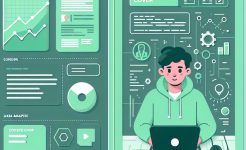Understanding Agile Risk Management
Agile risk management differs from traditional risk management approaches. In traditional project management, risk identification and planning are often done upfront in a comprehensive manner. However, in agile, the iterative and incremental nature of the process means that risks are continuously identified, analyzed, and addressed throughout the project lifecycle. Agile teams embrace uncertainty and view risks as opportunities for learning and improvement.
One of the key aspects of agile risk management is the concept of continuous feedback. Agile projects are divided into short sprints or iterations, during which teams deliver a working product increment. At the end of each sprint, there are retrospectives where the team reflects on the work done, including any risks that emerged. This feedback loop allows for timely identification of new risks and adjustment of risk mitigation strategies.
Another important element is the involvement of the entire team in risk management. In agile, everyone from developers to product owners and stakeholders is responsible for identifying and managing risks. This collaborative approach ensures that a wide range of perspectives are considered, increasing the likelihood of uncovering potential risks early on.
Risk Identification in Agile
Risk identification in agile projects is an ongoing process. It starts with the initial project kick-off and continues throughout each sprint. One common method is the use of risk burndown charts. These charts visually represent the number of identified risks over time, showing how the risk exposure is decreasing as the project progresses. By regularly updating the risk burndown chart, teams can easily track the status of risks.
Brainstorming sessions are also a crucial part of risk identification. During these sessions, team members come together to share their thoughts on potential risks. This can include technical risks such as compatibility issues with new technologies, or business risks like changes in market demand. Facilitators can use techniques like SWOT analysis (Strengths, Weaknesses, Opportunities, Threats) to guide the brainstorming process and ensure that all aspects are considered.
User stories can also be a valuable source for risk identification. As teams write user stories, they can identify risks associated with each story. For example, a user story that requires integration with a third-party system may have risks related to data security or system availability. By breaking down the project into user stories and analyzing each one for risks, teams can have a more detailed understanding of potential issues.
Risk Analysis and Prioritization
Once risks are identified, the next step is to analyze and prioritize them. In agile, a simple yet effective approach is to use a risk matrix. The risk matrix assesses risks based on two factors: likelihood and impact. Risks are plotted on a matrix, with likelihood on one axis and impact on the other. This allows teams to quickly categorize risks as high, medium, or low priority.

For example, a risk with a high likelihood of occurring and a high impact on the project, such as a major regulatory change that affects the product's functionality, would be considered a high-priority risk. On the other hand, a risk with a low likelihood and low impact, like a minor cosmetic issue in the user interface, would be a low-priority risk. By prioritizing risks, teams can focus their resources on addressing the most critical ones first.
Another aspect of risk analysis in agile is the consideration of time sensitivity. Some risks may not be critical immediately but could become so in the future. For instance, a potential shortage of a key resource may not be an issue in the current sprint but could cause delays in upcoming sprints. Agile teams need to take into account both the current and future implications of risks when analyzing and prioritizing them.
Risk Mitigation Strategies
After prioritizing risks, agile teams develop strategies to mitigate them. For high-priority risks, immediate action plans are put in place. For example, if a risk is related to a lack of expertise in a particular technology, the team may arrange for training sessions or bring in external consultants to address the issue.
Contingency plans are also an important part of risk mitigation. In case a risk does materialize, the team has a predefined plan to minimize its impact. For instance, if there is a risk of a server outage, the contingency plan could involve switching to a backup server and having a process in place to quickly restore data.
Agile teams also use the concept of risk-driven development. This means that work is prioritized based on the associated risks. High-risk user stories or tasks are given higher priority in the sprint backlog. By focusing on high-risk areas first, the team can reduce the overall risk exposure of the project as it progresses.
Monitoring and Control
Risk management in agile is not a one-time activity but an ongoing process of monitoring and control. The risk burndown chart mentioned earlier is a useful tool for monitoring risk status. By regularly updating the chart, teams can see if the number of risks is decreasing as expected or if new risks are emerging.
During daily stand-up meetings, team members can briefly discuss any new risks or changes in the status of existing risks. This allows for real-time communication and quick decision-making. If a risk situation worsens, the team can immediately adjust their plans and allocate additional resources if necessary.
At the end of each sprint, the risk management process is reviewed during the retrospective. The team discusses what went well in terms of risk management, what could be improved, and if any new risks have been identified. This continuous improvement approach ensures that the risk management process evolves with the project and becomes more effective over time.
In conclusion, risk management is an integral part of agile project management. The iterative and collaborative nature of agile projects requires a different approach to risk management compared to traditional methods. By continuously identifying, analyzing, prioritizing, mitigating, and monitoring risks, agile teams can increase the likelihood of project success. The use of tools like risk burndown charts, brainstorming sessions, and risk matrices, along with a focus on collaboration and continuous improvement, enables teams to effectively manage risks in the dynamic environment of agile projects. As projects become more complex and the business landscape more volatile, mastering these risk management methods will be crucial for agile teams to deliver high-quality products on time and within budget. Agile risk management not only helps in avoiding potential disasters but also in seizing opportunities for innovation and growth within the project. It allows teams to be proactive rather than reactive, making informed decisions at every stage of the project lifecycle. By embracing risk management as a core practice in agile, organizations can enhance their project delivery capabilities and gain a competitive edge in the market.
ARTICLE TITLE :Risk Management Methods in Agile Project Management ,AUTHOR :ITpmlib

















